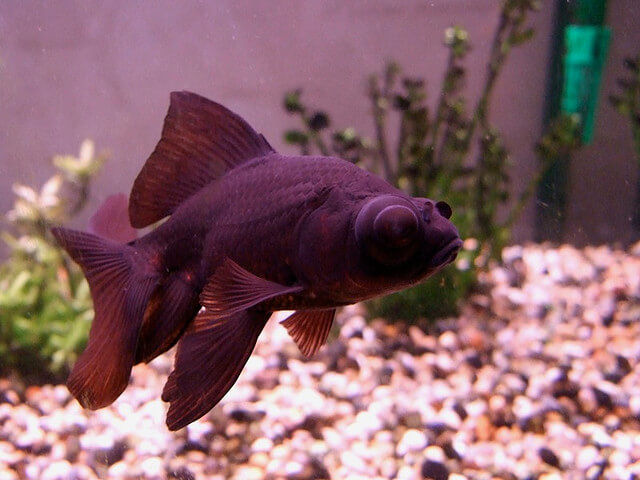Broadtail Moor Goldfish, also known as Black Moors, are a striking and popular variety among fancy goldfish enthusiasts. Known for their unique black coloration and protruding eyes, Black Moors require specific care to ensure their well-being. In this article, we will explore the distinctive physical characteristics of Black Moors and provide essential care guidelines.
Distinctive Physical Features
Black Moors are easily recognized by their deep black coloration, although some individuals may exhibit shades of brown or silver. Show-quality specimens have a flat sooty color, with no signs of metallic sheen. They possess a body shape similar to Veiltail Goldfish, with a single dorsal fin positioned high on their back and paired fins, including the caudal fin. The caudal fin should be fully divided, with rounded tips and no forked appearance. However, what sets Black Moors apart is their protruding eyes, similar to those of the Telescope Goldfish, which are located on the extreme tips of their protuberances.

Black Moor Goldfish Care Tips
Caring for the Broadtail Moor Goldfish, or Black Moor, requires attention to specific details to ensure their well-being and maintain their striking appearance. Here are important care considerations for this unique goldfish variety:
Compatibility and Feeding Considerations
Due to their poor vision, it is crucial to carefully choose tankmates for Black Moors. More agile and competitive breeds of goldfish may outcompete them when it comes to feeding, leading to potential malnutrition. Therefore, it is best to keep Black Moors with other slower-moving or similarly paced goldfish varieties. Suitable tankmates may include other fancy goldfish breeds such as Ryukins, Orandas, or Lionheads.
Feeding and Nutrition
To ensure that your Black Moors receive adequate nutrition, it is important to monitor their feeding habits. Be mindful that they may require more time to locate and consume their food. It is advisable to feed them sinking pellets or granules, as these will reach the bottom of the tank where the Black Moors can easily find them. Additionally, including a variety of foods in their diet, such as freeze-dried or frozen brine shrimp, bloodworms, or daphnia, will provide the necessary nutrients for their health and vitality.
Water Conditions and Tank Setup
Maintaining optimal water conditions is crucial for the well-being of Black Moors. Here are some key factors to consider:
- Water Parameters: Black Moors prefer slightly cooler water temperatures ranging from 65-75°F (18-24°C). Additionally, they thrive in well-oxygenated water with a pH level between 6.5 and 7.5. Regular water testing for ammonia, nitrite, nitrate, and pH levels is essential to ensure a healthy environment.
- Implement a reliable filtration system suitable for the size of the aquarium to maintain clean water and remove waste. Additionally, regular partial water changes of around 20-30% every week help keep the water parameters stable and prevent the buildup of harmful substances.
Eye Care and Health Considerations
- Due to their protruding eyes, Black Moors are more susceptible to eye-related issues, such as infections or injuries. It is important to maintain excellent water quality and minimize potential sources of stress to prevent eye problems.
- Regularly monitor the Black Moor for any signs of illness, including changes in behavior, loss of appetite, or visible abnormalities. If you notice any issues, consult with a qualified aquatic veterinarian or seek guidance from knowledgeable fishkeepers to address the problem promptly.
Sources:
- Stoskopf, M. K. (1993). Goldfish Varieties and Genetics: Handbook for Breeders. Tropical Fish Hobbyist Publications.
- Andrews, C. (2004). An Interpet Guide to Fancy Goldfish. Interpet Publishing.
- Hickling, C. F., & Hickling, M. K. (2006). Goldfish Varieties and Genetics: A Handbook for Breeders. TFH Publications.
Reviewed By: Tim Winter

Tim Winter has a strong affection for pets and wildlife. His years of experience caring for various types of pets has led him to share his knowledge with others on the best practices in pet care. Tim holds a Bachelor of Science from the University of Oregon School of Journalism and Communications.
